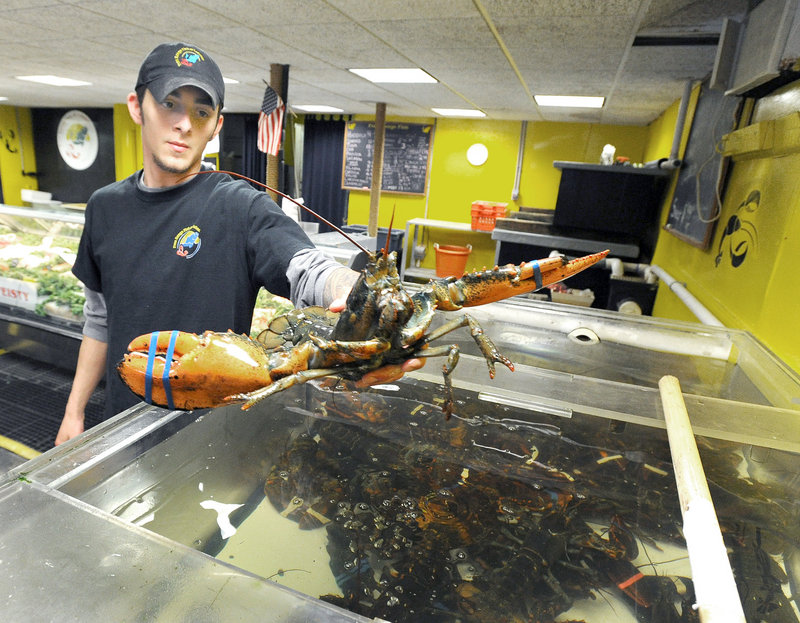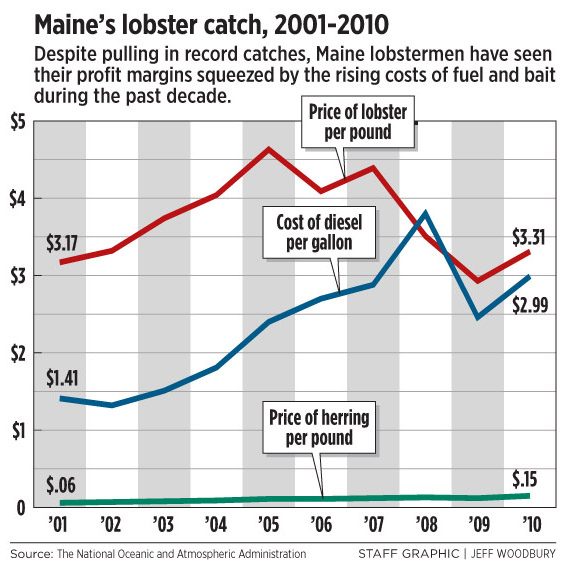Despite a record catch last year, Maine lobstermen face a season of uncertainty.
Soaring oil prices are pushing up the cost of diesel fuel. The supply of affordable bait remains unpredictable. And it is not yet clear whether the global appetite for Maine’s signature seafood has returned to pre-recession levels.
“This will be an interesting year to watch,” said Patrice McCarron, executive director of the Maine Lobstermen’s Association.
Mother’s Day is the informal kickoff for lobster season in Maine. It is when lobster shacks up and down the coast welcome early-arriving tourists and the phones start ringing at local lobster dealers with orders from far-flung locations.
Lobster is by far Maine’s most valuable fishery. Last year, the state’s 4,292 active lobstermen hauled 93.3 million pounds of lobster, valued at $309 million. The industry supports thousands of other jobs as crew members, and at associated businesses such as lobster dealers, processing plants, bait companies, restaurants and boat yards.
Last year’s record haul was a relief for a fishery sent reeling by the recession, when lobster prices plummeted. Although prices crept back up last year, when fishermen were selling their lobsters to dealers for an average of $3.31 a pound, prices are far from the peak of $4.63 a pound in 2005.
The average lobsterman’s profitability was positive and even improving in the 1990s and into the early 2000s. But Maine lobstermen’s profits have been headed downward ever since.
A study by the Gulf of Maine Research Institute concluded that by 2005, returns above operating costs for lobstermen averaged 33 percent — compared to 49 percent in 1993. Since then, the financial picture for lobstermen has only gotten worse, said Eric Thunberg, an economist with the National Oceanic and Atmospheric Administration.
For the past five or six years, fishermen have been feeling the squeeze from rising fuel prices and bait costs, driven by new limits on the catch of herring — the preferred bait of most lobstermen. Whale protection measures have required costly gear replacements. The number of active fishermen has dropped by 5 percent since 2008.
McCarron said the biggest stress factor this season is fuel, which has edged up to just pennies per gallon below the 2008 peak. During the last oil price spike, the cost of rope and other gear made out of petroleum-based plastics soared as well. But unlike fuel prices, those prices never subsided.
McCarron said high prices are going to hurt even more than three years ago. Today lobstermen have already taken steps to cut their overhead costs. Now there is little or no wiggle room left.
“Those adjustments to make their businesses as efficient as possible have happened,” McCarron said.
Fishermen say they are holding their breath over the price of bait, which can cost $250 to $600 a day. Some are hedging their bets, buying up what is available now and freezing it for later.
“People are really worried that supply will be limited with the quota on herring. We are definitely leaning more on other species, like redfish and pogies,” said John Jordan, a Chebeague Island lobsterman.
But the healthy stocks of lobster have saved the industry, McCarron said. Lobster stocks in southern New England are critically depleted due to lobster shell diseases caused by warming waters and overfishing. The stock is thriving in Maine, where the fishery is famous for its sustainable practices, such as license limits and a ban on landing lobster caught by dragging.
Carl Wilson, chief lobster biologist at the Department of Marine Resources, said while the stock has remained steady in southern Maine, it is booming in Hancock County, where a third of last year’s catch was landed.
Scientists do not know exactly why Maine’s stocks are faring so well, Wilson said, but it is probably a combination of factors. They include the warming New England waters, which may have pushed the lobster population northward; a decrease in predators such as cod from overfishing; and sound management practices.
“We don’t have the smoking gun,” Wilson said.
The lack of answers about what keeps Maine’s lobster population healthy fuels Maine lobstermen’s jitters about what the future holds for their fishery. That may explain in part why 2,700 Maine lobstermen, known for their independence and skepticism about government interference, signed up for help from a U.S. Department of Agriculture Trade Adjustment Assistance program last winter to develop business plans to make their operations more profitable.
“The ultimate magic formula is we have to continue to land enough product,” McCarron said.
But while there are troubling signs, the industry is far from pessimistic about its future. Despite soaring diesel prices and a cold wet spring, lobster boats have been bobbing into view off the coast in recent weeks, a sign of the eternal hopefulness of the industry.
“I am optimistic it will be a good season with decent prices,” said Alex Todd, a Chebeague Island fisherman.
For now, it appears the stock this year is as healthy as ever, at least according to anecdotal reports.
“We are seeing a lot of small ones,” Todd said.
The hope is those lobster will reach the legal size limit with the next molting in June.
There are recent signs that consumer demand is finally heading up. Joe Ray, owner of Free Range Fish and Lobster in Portland, said his retail sales are up 20 percent this year, especially at his locations in Manchester and Sanbornville, N.H.
The good news for consumers is that retail prices remain stable. Ray’s lobster is retailing at last fall’s levels: $6.99 a pound for the smallest, up to $9.99 a pound for jumbos.
“We are getting ready to tap a really big season,” Ray said.
Ronald Spinney, owner of Chauncey Creek Lobster Pier in Kittery, is opening for the season today, Mother’s Day, selling cooked lobster at $14.95 a pound at his waterfront eatery.
“Same as last year,” Spinney said.
Staff Writer Beth Quimby can be contacted at 791-6363 or at:
bquimby@pressherald.com
Send questions/comments to the editors.





Success. Please wait for the page to reload. If the page does not reload within 5 seconds, please refresh the page.
Enter your email and password to access comments.
Hi, to comment on stories you must . This profile is in addition to your subscription and website login.
Already have a commenting profile? .
Invalid username/password.
Please check your email to confirm and complete your registration.
Only subscribers are eligible to post comments. Please subscribe or login first for digital access. Here’s why.
Use the form below to reset your password. When you've submitted your account email, we will send an email with a reset code.